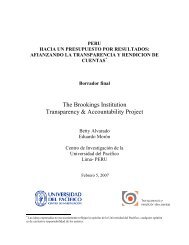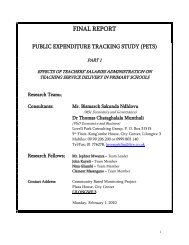Provider Purchasing and Contracting for Health Services_The Case
Provider Purchasing and Contracting for Health Services_The Case
Provider Purchasing and Contracting for Health Services_The Case
Create successful ePaper yourself
Turn your PDF publications into a flip-book with our unique Google optimized e-Paper software.
Favorable tax incentives are being offered to attract investors. Accordingly, it is envisaged<br />
that the private sector will extend investment in specialized services that the government is<br />
not able to offer. It is estimated that the country spends an average of US$3 to 6 million per<br />
annum by referring patients to neighboring countries <strong>for</strong> specialized services. Thus, it is<br />
envisaged that the private facilities will enter into contracts with the government <strong>for</strong> these<br />
services.<br />
9. Discussion, Conclusions, <strong>and</strong> Policy Implications<br />
Discussion of the results<br />
Following the re<strong>for</strong>ms, the government adopted contracting-in as a policy strategy to enhance<br />
the efficiency of resource use at various levels of the public health care system. According to<br />
fund holders, the policy has improved the allocation of resources in the entire health system<br />
as the Basic <strong>Health</strong> Care Package defined the services that are offered at each level of care.<br />
<strong>Contracting</strong>-in has enabled the fund holders to contract with other public <strong>and</strong> mission<br />
hospitals to supply the services they cannot supply. <strong>The</strong> guidelines <strong>for</strong> contracting-in are well<br />
articulated by the principal purchaser. <strong>The</strong> study found that about 35 percent of resources in<br />
the public health system flow through the contracting-in process at various levels of the<br />
referral system.<br />
<strong>The</strong> interviews revealed that the purchasing arrangement is riddled with uncertainty. Some<br />
respondents observed that contracts between the providers <strong>and</strong> the Ministry of <strong>Health</strong><br />
resemble a loose memor<strong>and</strong>um of underst<strong>and</strong>ing with no penalties or strict, en<strong>for</strong>ceable<br />
obligations <strong>for</strong> either party. Some of the District <strong>Health</strong> Management Teams <strong>and</strong> hospitals<br />
visited noted that contracts <strong>for</strong> 2007 were not signed by the Ministry of <strong>Health</strong>, contrary to<br />
the regulations. Furthermore, they are not funded according to the agreed-upon budgets <strong>and</strong><br />
action plans. This failure by the principal to honor its obligations makes the relationship<br />
between the contracting mechanism on one h<strong>and</strong> as well as the budgetary <strong>and</strong> action planning<br />
development processes on the other a routine activity that has no policy consequences. This<br />
finding rein<strong>for</strong>ces the earlier findings by Masiye <strong>and</strong> colleagues (2006), who observed that<br />
this undermines the role of the Ministry of <strong>Health</strong> as a purchaser.<br />
According to the 2006 National <strong>Health</strong> Strategic Plan, the gradual increase in the number of<br />
<strong>for</strong>-profit <strong>and</strong> not-<strong>for</strong>-profit private health service providers presents significant policy<br />
implications with regard to their involvement in the delivery of public health services. Since<br />
the initiation of the re<strong>for</strong>ms in 1991, the government has embraced the faith-based health care<br />
providers <strong>and</strong> they have been well integrated into the national health system. <strong>The</strong><br />
incorporation of mission hospitals into the <strong>for</strong>mal national health system through the<br />
memor<strong>and</strong>um of underst<strong>and</strong>ing with CHAZ, rein<strong>for</strong>ced by contracting with mission hospitals,<br />
has exp<strong>and</strong>ed enhanced health service delivery. CHAZ noted that this partnership has<br />
improved the delivery of quality health care by the mission hospitals to the poor of the<br />
poorest in rural <strong>and</strong> remote areas. As observed in the study, mission hospitals are mainly rural<br />
<strong>and</strong> offer what is perceived to be holistic <strong>and</strong> the best quality of health care.<br />
An important initial objective of the purchaser-provider split was the need to create <strong>and</strong><br />
develop a functional internal market within the public health sector. In addition, the internal<br />
market was designed to strengthen the public-private partnership. From the analysis, there<br />
57
















